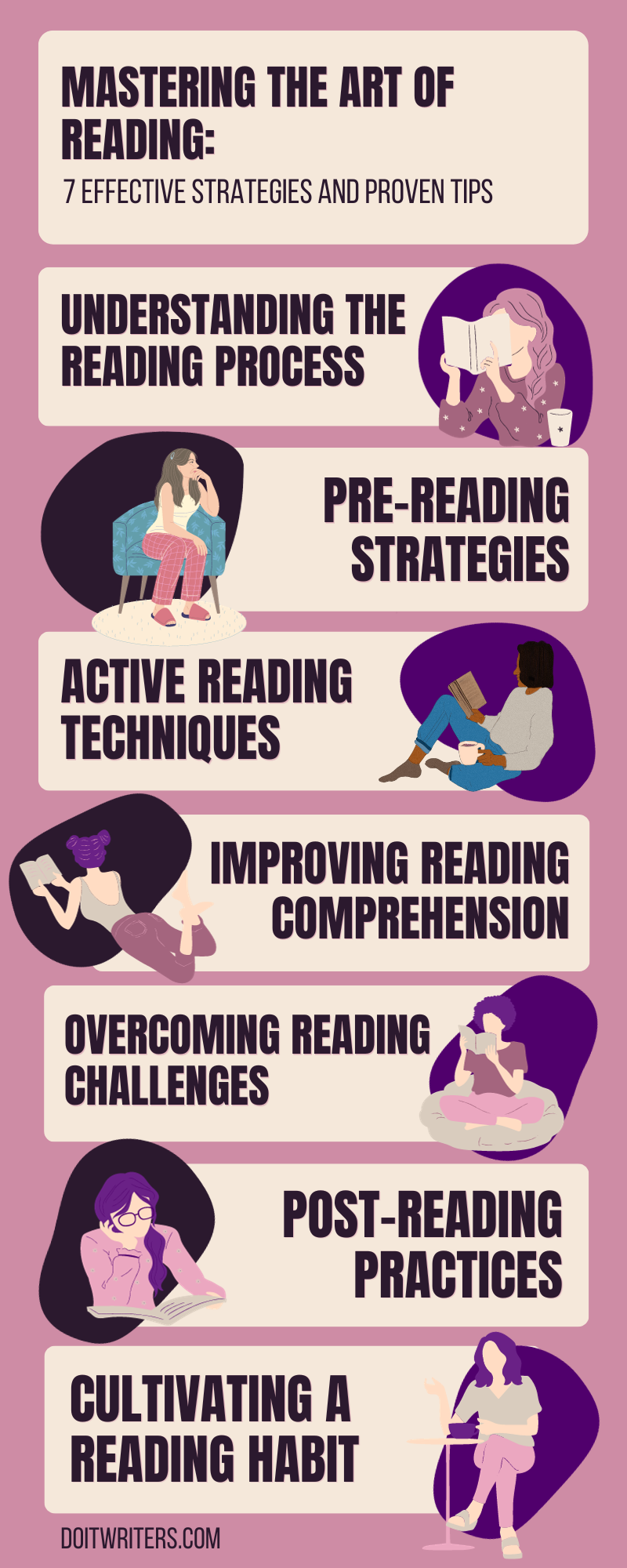Let’s dive into a world where words dance off the page, where sentences paint vivid pictures, and paragraphs become portals to endless possibilities. The art of reading isn’t just about following lines of text; it’s about unlocking a universe of knowledge and imagination.
Think of it as a superpower—one that lets you absorb information, understand diverse viewpoints, and fuel your curiosity.
In this article, we’ll explore the secrets behind effective reading strategies and proven tips that can transform the way you absorb and interpret information.
Reading Strategies and Tips
Unlock the potential of every page with these essential Reading Strategies and Tips!
1. Understanding the Reading Process
Reading is like a magic window that opens up whole new worlds. When we read, we use our eyes to look at words, and our brain turns those squiggles into meaning. It’s not just about saying words out loud; it’s about understanding what those words mean.
We read to learn, to enjoy stories, to find information—basically, it helps us make sense of everything around us.
Importance of Effective Reading:
Think of reading as your secret superpower. It’s not just about reading words; it’s about understanding them. Imagine you’re a superhero and each word is a tool in your belt. When you read well, you understand better.
This skill helps in school, at work, and even when you’re just chatting with friends. Good reading means you can understand instructions, learn new things, and enjoy amazing stories. It’s like having a treasure map to knowledge and fun!
That’s why being a good reader is super important—it opens doors to endless possibilities.
Understanding the reading process is like discovering the magic behind how we make sense of words, and effective reading is the key that unlocks countless opportunities in life.
1. Understanding the Reading Process
Before we jump right into reading a book or an article, it’s like taking a sneak peek. We look at the cover, maybe flip through the pages quickly, and read titles or headings. This helps us get a feel for what the whole thing is about without reading every single word yet. It’s like checking out the menu before picking what you want to eat!
Setting Objectives:
Imagine you’re on a mission in a game. You have a goal, right? That’s what setting objectives in reading is like! It’s deciding what you want to learn or understand from what you’re going to read.
Maybe it’s finding out about animals in a book or learning how to do something new. Having these goals helps us focus and understand things better.
Activating Prior Knowledge:
We already know lots of things! Using what we already know helps us understand new stuff better. Let’s say you’re reading about space.
If you already know about stars and planets, it’s easier to understand more complicated things about space travel or black holes. It’s like building a big tower with the bricks of what you already know.
Pre-reading strategies are like getting ready for a fun adventure—by taking a peek, setting goals, and using what we already know, we make our reading journey smoother and more exciting!
3. Active Reading Techniques
Imagine your book or article is like a treasure map, and annotations are your clues! When we make notes or marks in the margins (the empty spaces beside the text), we’re like detectives jotting down important clues or thoughts. It helps us remember key points or understand tricky bits better, just like leaving notes for ourselves!
Questioning the Text:
Reading is like having a conversation with the book! When we ask questions about what we’re reading, it’s like we’re chatting with the story or the information. We might wonder why something happened or what might happen next. Asking questions helps us think deeply and understand things better.
Visualization:
Close your eyes and imagine! When we read, we can create pictures in our minds, almost like watching a movie. Visualizing helps us understand better because we can see things happening in our heads. It’s like painting a picture with words from the book!
Active reading techniques are like using tools to explore a fascinating world in a book. By making notes, asking questions, and creating mental pictures, we make our reading experience more interactive and enjoyable!
4. Improving Reading Comprehension
Words are like puzzle pieces that make up stories and information! When we want to learn new words, we can use tools like dictionaries or even context clues from the sentences around them. Understanding new words helps us understand what we’re reading better, just like learning new tools to build cool things!
Summarization Skills:
Summarizing is like making a short movie trailer for a big, long film! After reading something, we pick out the most important bits and put them together in a shorter version. It’s like taking the highlights so we can remember the main ideas without having to remember every single detail.
Making Connections:
Imagine your brain is a big spider web! Making connections means linking what we’re reading to things we already know or have experienced. It’s like saying, “Oh, this reminds me of that other thing!” This helps us understand better because we’re connecting new ideas with stuff we already understand.
Improving reading comprehension is like putting on special glasses that make everything clearer! By learning new words, summarizing key points, and connecting ideas, we make reading more fun and easier to understand.
5. Overcoming Reading Challenges
Sometimes, reading can feel like trying to drink from a fire hose! When there’s a lot of information at once, we can feel overwhelmed. To handle this, we can take breaks while reading, go slow, or even break the big text into smaller parts. It’s like eating a huge pizza slice by slice instead of all at once!
Handling Difficult Material:
Have you ever faced something super hard in a video game? It’s tough, right? But then you find new strategies or ask for help. Reading difficult stuff is similar!
We can use tools like dictionaries or ask someone who knows more about the topic to explain tricky parts. It’s like having a secret guidebook to help us through the tough bits!
Overcoming reading challenges is like finding the right tools or tricks in a game. By taking breaks with complex texts and using strategies to tackle tough subjects, we make reading challenging material less daunting and more manageable!
READ MORE: What Common Challenges Do Readers Face And 3 Easy Ways To Overcome Them
6. Post-Reading Practices
After finishing a book or an article, it’s like taking a moment to look back on an exciting journey! Reviewing means thinking about what we read and asking ourselves questions like: “What was the story about?” or “What did I learn?”.
Reflecting is like thinking about how the story or information makes us feel or what we think about it. It’s like talking to ourselves about what we just read!
Applying Knowledge:
Imagine you’ve collected cool tools from a treasure hunt! Using what we’ve learned is like using these tools in real life. If we learned about animals, we might go to the zoo to see them or tell our friends about what we read. It’s like using what we know to do something fun or helpful!
Post-reading practices are like wrapping up a fun adventure and then using the souvenirs we collected in our everyday lives. By reviewing what we read and using what we learned, we make our reading experiences even more valuable and exciting!
7. Cultivating a Reading Habit
Think of reading like exercising for our brains! Just like doing exercises regularly makes us stronger, reading regularly makes our brains stronger too.
Consistency means making a habit out of reading every day or every week. It could be for a short time, like 10 minutes before bedtime, or longer if you enjoy it! It’s like watering a plant regularly so it grows big and healthy.
Finding Enjoyment in Reading:
Reading can be like exploring a new world or going on an adventure! To enjoy it more, we can choose books or stories about things we love—like animals, space, or magic! Also, finding a comfy spot and making it cozy with blankets or pillows can make reading extra enjoyable.
It’s like creating a special place just for our reading adventures!
Cultivating a reading habit is like making a new friend: the more time we spend together, the closer we become! By reading regularly and making it enjoyable with books we love and cozy spots, we turn reading into a fun and comforting part of our lives.
Conclusion:
In our journey through mastering the art of reading, we’ve unveiled seven powerful strategies to level up our skills. We’ve learned to preview texts, set goals, and activate what we already know before diving in.
Annotation, questioning, and visualization have become our trusty tools for active reading. Summarizing key points, expanding vocabulary, and making connections have enhanced our comprehension.
Remember, practicing these techniques turns reading into an exciting adventure! So, let’s embark on this journey together. Embrace these strategies, explore new worlds through books, and watch as your understanding and enjoyment of reading soar.
Open that book, start that article—let’s read, learn, and grow!

















